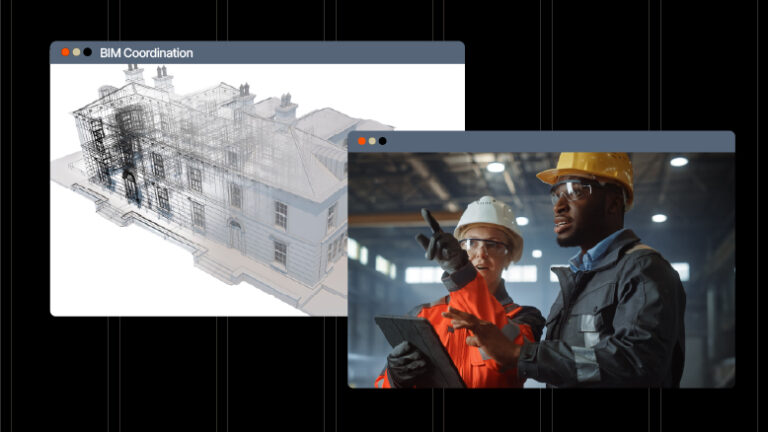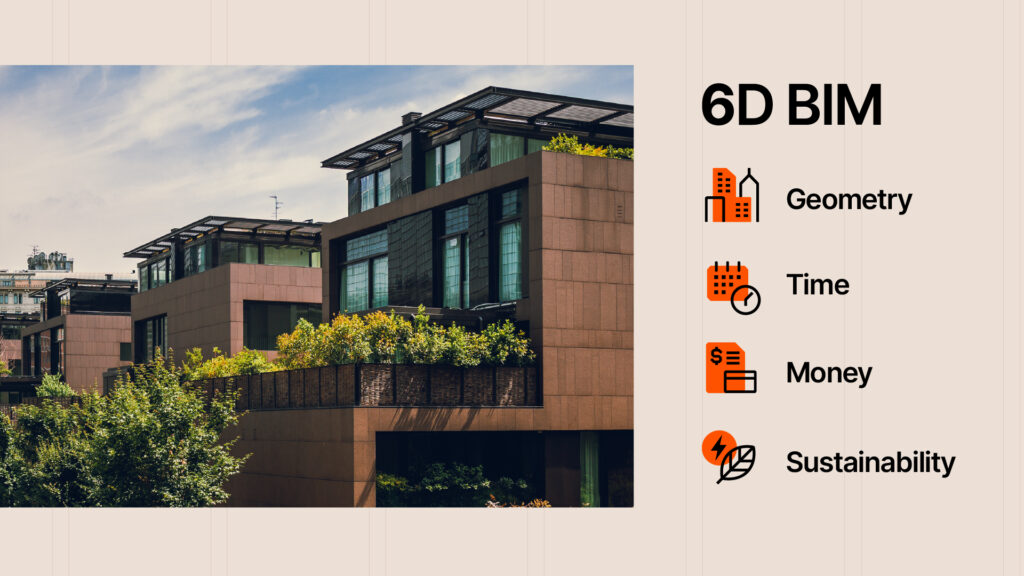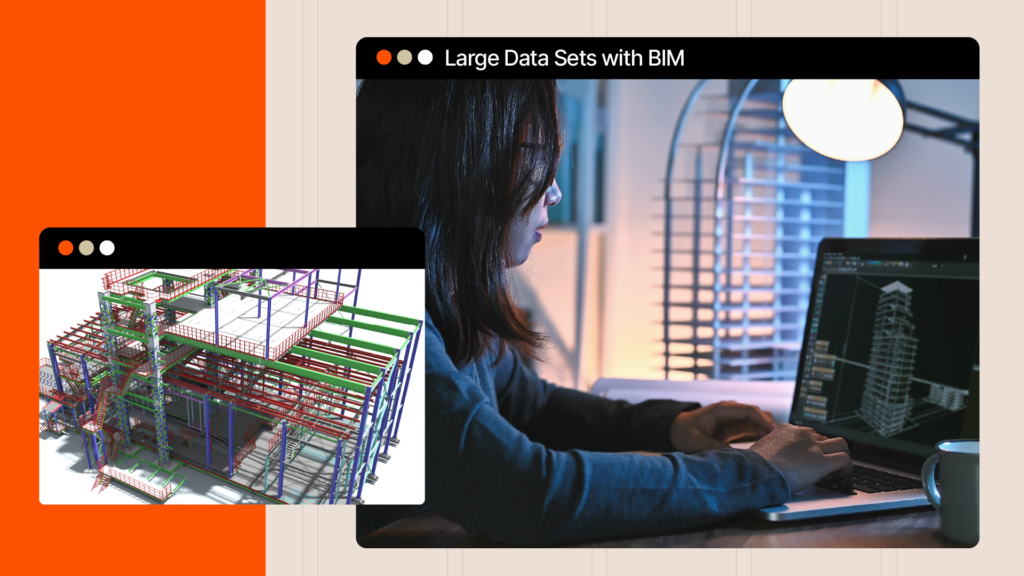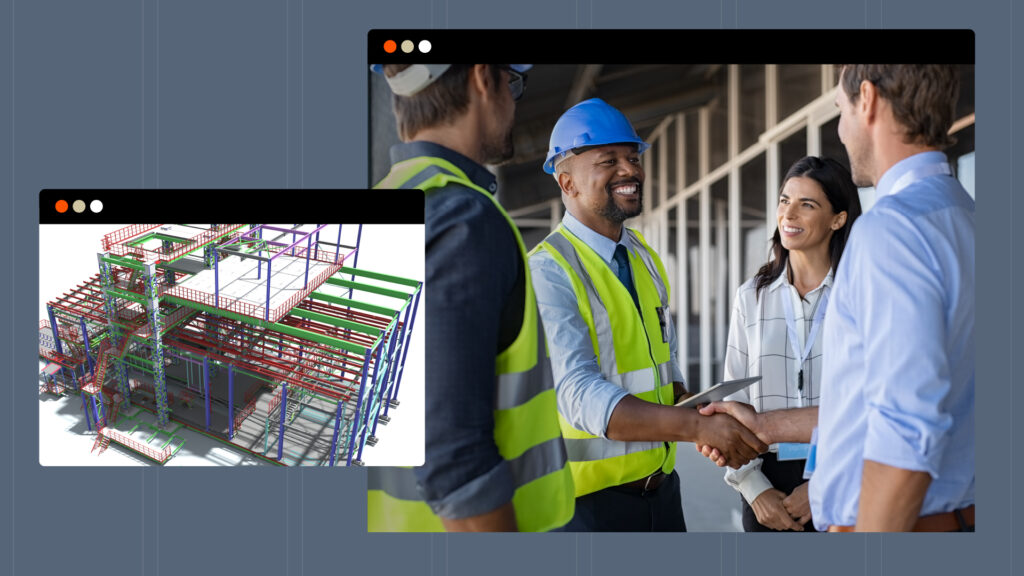— 7 min read
Streamlining Construction Projects with Effective BIM Coordination
Last Updated Apr 22, 2025
Last Updated Apr 22, 2025

The old saying goes: if you fail to plan, you plan to fail. Construction professionals know this better than nearly anyone. To take a project from a vision in an owner’s mind to a design is one thing; to actually erect a useful, comfortable building is entirely another.
It’s no surprise, then, that coordination is a major undertaking on any project. This effort connects the owner, design teams, the general contractor (GC), and specialty contractors. It aims to align everyone behind the same plan, including a detailed schedule of installation. Coordination can encompass everything from the safety measures required on-site to getting the right equipment to the jobsite at the right time.
Fortunately, a robust tool can make construction coordination easier. Building information modeling (BIM) delivers a detailed 3D model of the project. Coordinating that model unlocks a planning exercise that can help the project run on time, on budget, and in alignment with the owner’s goals.
Table of contents
Supporting Coordination with BIM
In the U.S., it’s commonplace to try to move out of preconstruction as quickly as possible. People often don’t get paid until construction activities start, so they’re motivated to get to that point rapidly.
The problem, though, is that the drawings that come from design teams usually aren’t perfect. These teams focus on converting the owner’s intent into the design, not on constructability. As a result, rushing through coordination often means issues don’t get caught until they affect workers in the field. At that point, they might stop progress or even require rework.
At least, that’s the case if BIM isn’t deployed on the project. Fortunately, the model can help here. It gives stakeholders a way to coordinate the entire project using a single model. The latest technologies can help to speed coordination efforts by handling certain checks automatically, too.
With BIM coordination, stakeholders use the 3D model of the project to try to uncover as much as possible to drive project success. By catching problems earlier and identifying areas for optimization in the digital space, changes are cheaper, easier and faster to make.
Most BIM-backed projects use clash detection, for example. This automatically checks the entire model for any spots in which two solids collide.
Looking at the project in 3D makes it easier to plan for installation in congested areas like corridors and overhead spaces, too. And as the modeling effort supports spatial coordination, it can help planners create safer work environments in those tight spaces.
BIM also supports sequencing, particularly if teams apply 4D BIM. This coordination effort could help shrink the size of the project’s laydown yard by finessing the timing for different material deliveries and equipment uses.
All of this said, BIM hasn’t yet replaced traditional coordination efforts. Instead, it currently serves as an enhancement to these processes.
As many construction professionals who’ve used BIM for coordination will report, it helps. If BIM coordination didn’t turn up any issues that needed to get resolved, it would likely be the first time that’s ever happened.
BIM and Collaborative Coordination
BIM becomes a particularly effective coordination tool when teams come together to create a multi-disciplinary (i.e., federated) model. This way, the GC and specialty contractors contribute to the modeling effort to build a unified model. That creates a single source of truth that all teams can leverage to stay aligned moving forward.
As IT expert Jeff Sample says, “Coordination is contractual. Collaboration is cultural.” The invitation to contribute to the multi-disciplinary model creates an environment in which subcontractors have a seat at the table. Everyone can come together to see the complexity of what needs to be installed. Stakeholders can voice concerns or needs. And because the project is coordinated in the model, those things have the opportunity to get resolved as that coordination happens.
The collaboration that BIM coordination encourages can continue all the way to closeout, too. If that model gets handed over to the owner, it connects them and their facilities team to the building. Say, for example, that one area is particularly tight since all of the building’s systems converge there. The model may help the owner understand that by giving them a visual.
With this visualization of what’s happening behind walls and ceilings, owners have a way to see the results of the GC's and trade contractors' efforts. Just as importantly, the model gives their maintenance teams clarity into access points for serviceable systems.
Using BIM and Prefabrication for Smoother Coordination
Prefabrication is an increasingly popular option on construction projects, and for good reason. When components can be created off-site, that prefabrication can, as one study noted, deliver a number of benefits. Those include:
- More efficient production by using sites set up for the fabrication of that specific component
- Greater project speed because teams can work off-site, then come to the site to get install handled in a matter of hours or days
- Better safety and ergonomics (e.g., ductwork that would need to be installed on a ceiling can be prefabricated on the ground in sections, minimizing how much time workers need to spend at heights)
- Quality control by fabricating in a confined, dedicated environment
- Quality assurance via testing performed in the prefab environment before the component it brought to the jobsite
Poor coordination makes prefabrication risky, though. Stakeholders want assurance that components will interface seamlessly with the built environment. If they don’t, installation can become a nightmare, quickly offsetting any efficiency gains.
Fortunately, sophisticated contractors can leverage the model to effectively coordinate their prefabricated elements. With BIM in play, prefabrication becomes feasible and unlocks all of the benefits outlined above.
Bringing Coordination Efforts to the Field
Coordination starts in the office during preconstruction, but it’s an ongoing effort all the way through to closeout.
There should never be a disconnect, then, between the coordinated plan and the workers in the field. Finding ways to create field access to the coordinated model helps here. Fortunately, leading-edge technologies are making this easier than ever.
Users can, for example, turn on the camera on their tablet to see an augmented reality (AR) view that overlays the model with the real world. This can help installers see what’s been spatially coordinated in the space so they can make sure their work aligns.
Build a Strong Foundation with our Preconstruction Course
With 20+ years of experience, Ben Ashburn teaches you how to streamline planning, bidding, and procurement for better outcomes.

Achieving Continued Coordination Wins With BIM
When done thoroughly, coordinating the project in a 3D digital space can significantly streamline the work on the jobsite. In short, coordinating the model builds in a planning exercise that helps projects run on time and on budget.
That assumes, though, that teams leverage the model in an effort to figure out how to streamline the project. If they’re merely creating a model to tick a box required by the owner, efforts will probably fall short.
Getting the most out of BIM coordination means approaching it with a plan. Specifically, a BIM execution plan (BEP) can help with everything from smoother collaboration with subcontractors to fewer technical hurdles. With a BEP, everyone gets a way to understand the modeling process and how the resulting model will be used for coordination and beyond.
Ideally, the BEP spells out ways to connect the model to the other tools in the project’s tech stack. Connecting the model to the request for information (RFI) management platform, for example, means that issues caught during clash detection can be more effectively resolved.
To drive continued project wins, BIM coordination can’t happen in a silo. It needs to connect the design team, GC, and specialty contractors with each other and the owner’s vision. It needs to integrate with other technological tools used on the project. And it also needs to give all stakeholders visibility into the project.
When everyone can come to the table to collaborate, BIM coordination becomes a project accelerator.
Was this article helpful?
Thank you for your submission.
0%
0%
You voted that this article was . Was this a mistake? If so, change your vote here.
Scroll less, learn more about construction.
Subscribe to The Blueprint, Procore’s construction newsletter, to get content from industry experts delivered straight to your inbox.
By clicking this button, you agree to our Privacy Notice and Terms of Service.
Categories:
Tags:
Written by
DJ Phipps
9 articles
DJ Phipps has spent over two decades working in the building and design industry. He's dedicated to using technology to make work easier and more efficient, with a focus on project management and improving systems. DJ now plays a key role at Procore as a Senior Principal Strategic Product Consultant.
View profileKacie Goff
55 articles
Kacie Goff is a construction writer who grew up in a construction family — her dad owned a concrete company. Over the last decade, she’s blended that experience with her writing expertise to create content for the Construction Progress Coalition, Newsweek, CNET, and others. She founded and runs her own agency, Jot Content, from her home in Ventura, California.
View profileExplore more helpful resources

The Role of BIM in Sustainable Construction
Building information modeling (BIM) is transforming the architecture, engineering, and construction (AEC) industry. With this kind of sophisticated modeling, the industry has shifted from designing in 2D to 3D. This helps...

Building and Using Large Data Sets with BIM
In recent years, two technological concepts have exploded, almost in parallel: One, called building information modeling (BIM), makes it possible for stakeholders to “build” construction projects in a 3D virtual...

Exploring BIM’s Potential in Manufacturing Construction
As building information modeling (BIM) improves, project owners can build more sophisticated facilities faster. And as consumers increasingly demand what they want delivered to them faster, brands need smarter manufacturing...

How BIM Enhances Control and Efficiency for Project Owners
Any construction project has a number of stakeholders. With a traditional project delivery method, it moves from designers and engineers in the architectural design process, to the general contractor and...